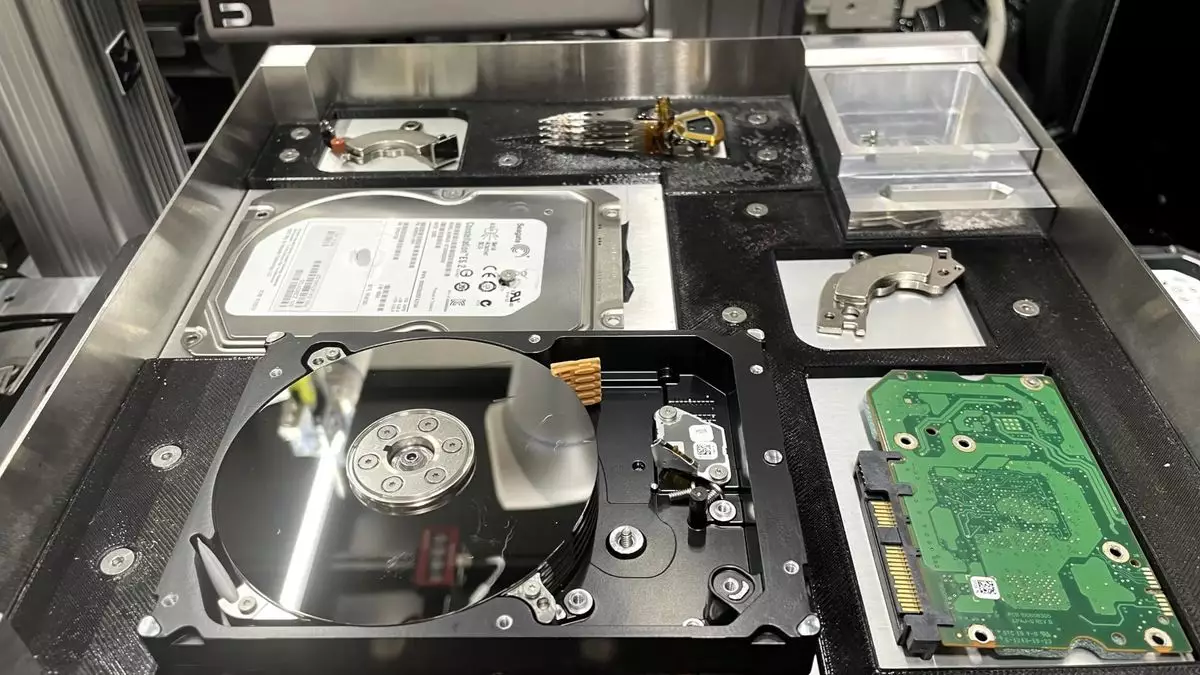Every year, the world faces a staggering surge in electronic waste (e-waste), with a staggering 50 million metric tons generated globally. Among the various components contributing to this crisis, defunct hard drives play a significant role. The conventional method involves shredding and grinding these drives to prevent unauthorized access to sensitive data, resulting in vast volumes of recyclable material being carelessly discarded. However, companies like Microsoft are emerging as trailblazers in seeking innovative solutions to tackle this critical problem by turning towards robotics and artificial intelligence.
Recognizing the environmental implications of improper e-waste management, Microsoft launched an initiative dubbed “Secure and Sustainable Disposal of Hard Disks” during its 2022 Global Hackathon. The ambitious objective set forth by this project aimed for a remarkable 90% reuse and recycle rate for hard drives by the year 2025. Given the staggering figures published by Microsoft, which indicated that between 20 to 70 million hard drives are rendered obsolete annually, it is clear that new methods are imperative to address this growing challenge efficiently.
Rather than continuing with outdated practices, like simple shredding, Microsoft is now leveraging cutting-edge robotics and machine learning. The end goal is to automate the arduous process of disassembling hard drives. By implementing technology, Microsoft aspires to recover and recycle valuable components, such as neodymium magnets, while only relegating the platters to the shredder.
The integration of robotics in e-waste management is not just a buzzword; it represents a paradigm shift in how we handle electronic discards. The symbiosis of robots and AI creates a system capable of performing repetitive and tedious tasks required to dismantle hard drives efficiently. While the underlying technology is impressive, executing this project on an industrial scale is incredibly challenging.
The diversity among hard drives lies not only in their dimensions but also in their internal components—screws, circuit boards, and various parts that require selective disassembly based on material properties and structural design. A robotic system must undergo extensive training to accurately recognize and sort these components, which involves an intricate interplay of machine learning and real-time decision-making capabilities.
Not only does Microsoft’s initiative address the hard drive e-waste issue, but it also paves the way for similar approaches to be extended to larger electronics like laptops and desktop computers. The complexity involved in dismantling whole systems presents a considerable challenge due to their integrated nature and variety of parts. Nevertheless, the potential for recovering valuable materials from these devices cannot be overlooked.
By focusing efforts on refining robotic technology and machine learning applications specifically for complex electronic devices, Microsoft and similar entities could significantly augment the sustainability of e-waste management. As environmental concerns increasingly shape corporate strategies, the movement toward sustainable recycling practices will likely gather momentum, leading to innovations that transform how we dispose of our aging technology.
Despite the hurdles that lie ahead, the pursuit of achieving higher reuse and recycling rates within the e-waste sector is optimistic. By promoting sustainable disposal methods, the partnership between robotics and AI is positioning itself not merely as a technological marvel but as a vital component of responsible corporate citizenship. Companies that acknowledge the implications of e-waste and take concrete steps toward mitigative strategies will ultimately set new benchmarks for sustainability in the technology sector.
While e-waste poses a significant dilemma for our planet, initiatives such as Microsoft’s project indicate a future where innovative solutions effectively combine technology and environmental stewardship. As the robotics industry continues to evolve and adapt, there is every reason to believe that the dream of a more sustainable e-waste recycling ecosystem can become a reality. The commitment to recycling hard drives and other electronics properly not only reduces environmental impact but also contributes to a circular economy, ensuring valuable materials are preserved for future generations.

